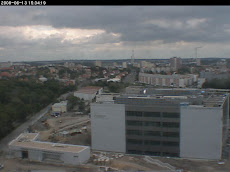We just got back to Prague after spending a couple of days in eastern Austria, in the area known as Burgenland. It was both a vacation to enjoy the wonderful scenery of Burgenland and also to do some genealogical research since my paternal grandmother's family - the Sattlers - emigrated to the US from Burgenland (more on that later).
Kathy and I did a little reading on Burgenland before we left, but we still found out a couple of very interesting facts. The first is that after the end of World War II, Burgenland was part of the Soviet zone. The second is that more than 20,000 Hungarian refugees crossed the border into Austria near Andau when the Soviets crushed the Hungarian revolution in 1956 (as they would crush the Czech revolution 12 years later).
From Wikipedia:
Burgenland was...given to the Soviet forces in exchange for Steiermark (Styria), which was in turn occupied by the United Kingdom.
Under the Soviet occupation, people in Burgenland had to stand a time of serious mistreatment and an extremely slow economic progression, the latter induced by investor-discouraging presence of the Soviet troops. The Soviet occupation ended with the signing of the Austrian Independence Treaty of Vienna in 1955 by the Occupying Forces.
The brutally crushed Hungarian Revolution on October 23, 1956 resulted in a shockwave of Hungarian refugees at the Hungarian-Austrian border, especially at the Bridge of Andau (Brücke von Andau), who were received by the inhabitants of Burgenland with an overwhelming amount of hospitality.
In 1957, the construction of the "anti-Fascist Protective Barrier" resulted in a complete bulkheading of the area under Soviet influence from the rest of the world, rendering the Hungarian-Austrian border next to Burgenland a deadly zone of mine fields (on the Hungarian border) and barbed wire, referred to as the Iron Curtain. Even during the era of the Iron Curtain, local trains between the north and south of Burgenland operated as "Corridor trains" (Korridorzüge) – they had their doors locked as they traversed Hungarian territory.
Starting in 1965 and finishing in 1971, the minefields were cleansed because people were often harmed by them, even on the Austrian side of the border. This could well be taken as a sign of the Soviet Union towards opening the borders to the Western countries, starting in the late seventies.
Here is where tens of thousands of Hungarian refugees crossed into Austria in 1956.
The border between Hungary and Austria at Andau as it looks today. With Hungary and Austria both in the EU, new rules that took effect last December means that now there aren't even any border guards or any hindrance in crossing the border. It's like going from Minnesota to Wisconsin.
An interesting side note, James Michener wrote a book entitled "The Bridge at Andau" in 1957 that chronicled the Hungarian Revolution of 1956. Michener was living in Austria in the 1950s.
Saturday, May 10, 2008
Back from Burgenland...
Posted by
Al Tischler
at
7:50 PM
![]()
![]()
Subscribe to:
Post Comments (Atom)


1 comment:
Dear Sir/Madam,
I would like to buy a link in the text on your site http://tischlersinprague.blogspot.com/.
Please let me know how much it is to have a link in the text in all pages of your site (please note: we are not interested in Google ads and banners). The link should be in static html. Payment will be by PayPal.
If you are not interested then please indicate this in a reply and we will not disturb you anymore.
Yours faithfully,
Nicole Williams
Post a Comment